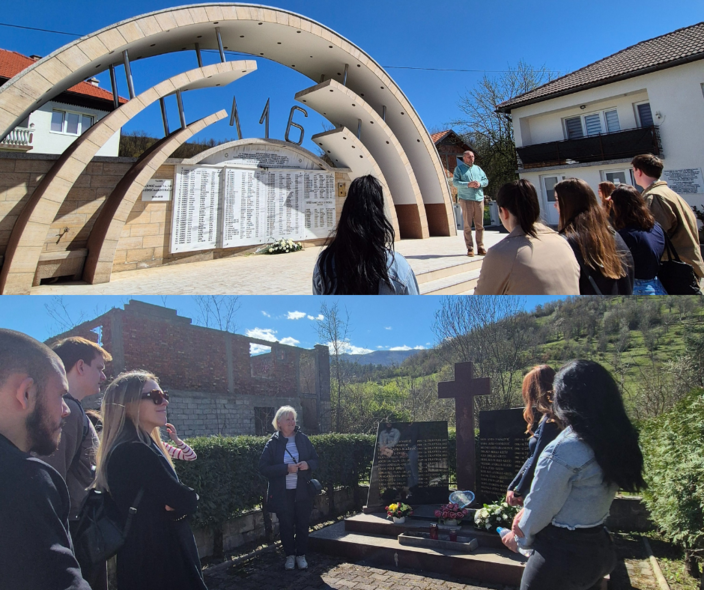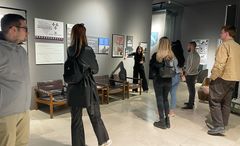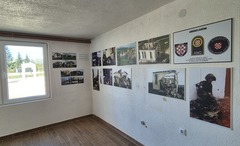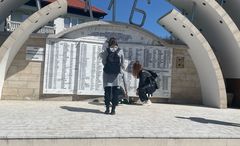The Youth Initiative for Human Rights – Croatia and the Youth Initiative for Human Rights – Bosnia and Herzegovina, in collaboration with the Friedrich Ebert Foundation in Bosnia and Herzegovina, organized a study trip to Ahmići and Trusina from April 11 to 13, 2025. The trip took place on the weekend preceding the joint commemoration of the crimes committed on April 16, 1993. For the youth from Croatia and Bosnia and Herzegovina, this trip was an opportunity to commemorate and learn about a difficult chapter in the history of their countries. A similar trip was organized two years earlier on the occasion of the 30th anniversary of these two crimes.
Introductory Workshop
Ten activists from three different countries gathered on Friday morning for an introductory workshop in Sarajevo, focusing on the crimes committed in Ahmići and Trusina. After a brief presentation providing context and evidence-based information about these events, participants reviewed historical footage and listened to recorded testimonies gathered by the International Criminal Tribunal for the former Yugoslavia (ICTY) and the Court of Bosnia and Herzegovina. The workshop also provided an opportunity for activists to share their thoughts and discuss how to approach and cope with these difficult topics and the processing of emotions which would arise during the visits.
Visiting Trusina
On Friday, April 11, the group visited Trusina, where on April 16, 1993, members of the Army of the Republic of Bosnia and Herzegovina (ARBiH) killed 22 Croats, including 15 civilians and seven captured soldiers of the Croatian Defense Council (HVO). Four civilians were also wounded, two of whom were children.
The participants laid flowers and held a minute of silence at the memorial site for the victims, alongside Cecilija Anđelić, who shared her testimony about the events in Trusina.
In her speech, she emphasized the importance of remembrance and responsible dealing with the past to prevent such crimes and violence from happening again. She also reminded us to approach everyone with understanding and tolerance, not to hate anyone and to forgive but never to forget. Cecilija also joined the group on a walk through the village, which still shows signs of war destruction and was further and significantly affected by floods in October 2024.
Visiting Ahmići
The next day, on April 12, the group visited Ahmići, the site of a mass crime against civilians committed on April 16, 1993. On that day, members of the Croatian Defense Council (HVO) and special units of the HVO Military Police, the so-called "Jokers," killed 116 Bosniak civilians, including 11 children and 32 women. The youngest victim was only three months old, and the oldest was 82 years old. These mass crimes, along with the destruction of mosques and nearly all Bosniak homes in Ahmići, were a part of an organized ethnic cleansing campaign in Central Bosnia. The participants were greeted by Imam Mahir ef. Husić, who spoke to the group and guided them through a memorial room displaying testimonies from witnesses and survivors, as well as photographs documenting the crimes committed. The Imam also shared with us the current social challenges faced by the residents, emphasizing: “Before this event, we all knew each other, socialized, and went for coffee... We celebrated Christmas and Eid, and now we barely greet each other.”
As in Trusina, the group laid flowers at the memorial for the victims and held a minute of silence before walking through the site. Unlike Trusina, the population of Ahmići has increased in the years after the armed conflict. At the end of the walk through Ahmići, we spoke with survivors and witnesses of the crimes in Ahmići, including a family whose house was completely destroyed and whose closest family members were killed. They shared their experience with us and said that they often relive the tragic moments, emphasizing that, as they grow older, it becomes more and more difficult for them, especially before and during the crime’s anniversary.
Reflection
After returning from Ahmići to Sarajevo, the entire group dedicated time to sharing their impressions of the trip and what they had learned about the crimes in Trusina and Ahmići. We also talked about the emotions we experienced and ideas about how all of us can contribute to preventing violence and such crimes from happening again. Here are some of the comments and thoughts shared by the participants:
“Both villages are surrounded by beautiful, idyllic landscapes. With the unclear boundaries between old and new destruction in Trusina and the return of life in Ahmići, it is hard to imagine the horrors that occurred there relatively recently. The stories of the victims and witnesses are not just part of history – they are still being told, and they are being told by those who still live them, parallel to us.
Even if you have read about the crimes or seen photographs (which, unfortunately, many still have not), it is difficult to reconcile the horror with the current, apparent peace. Without constant efforts to uncover the truth, prosecute the guilty, commemorate, and seek a way forward, it will not be possible to confront what happened in those villages.”
“The people there were so welcoming towards us, and they were happy that we had not forgotten them...”
“The most striking thing for me was the woman in Ahmići who said she is still afraid... We promised we will not let anything like that to happen again.”
“It was especially encouraging to hear from the survivors and witnesses of both crimes calling for coexistence, dialogue, and solidarity. This is exactly what makes this program inspiring and special: it is a step toward understanding the past, human suffering, and pain. I felt faith in coexistence, human compassion, and the strength of empathy that will prevent the recurrence of such crimes in the future.”
After the discussion, the group had the opportunity to visit the Historical Museum in Sarajevo, where they toured an exhibit that shows what life was like during the 44-month siege of the capital of Bosnia and Herzegovina, Sarajevo.
Next Steps
Organizing study trips like this plays a crucial role in educating young people about war crimes, human rights violations, and the importance of responsibly confronting the past and inclusive memorialization. Through guided visits to sites of suffering, participants not only gain essential insights into the (judicially) established facts about these events but also actively participate in the development of inclusive memorialization in the former Yugoslavia.
Such trips allow young people to understand the importance of commemorating all victims, regardless of their ethnic background, contributing to the building of a society based on reconciliation and shared responsibility for confronting our violent past. All participants in this study trip expressed great satisfaction with having had the opportunity to participate and emphasized that such trips should be organized more frequently so that more young people can gain insight into the facts about human rights violations as well as to experience the importance of memorialization and the commemoration of all victims of armed conflicts, regardless of nationality.
The participants also stressed that such events have a long-term impact on them, as they help them understand the deep connection between the past and the present and encourage them to share the knowledge they gained within their communities. As they themselves pointed out, such experiences prompt them to recognize their own responsibility in confronting the past, motivating them to contribute through various forms of expression, such as poetry, writing blogs or activism with the goal of encouraging a responsible approach to the past and create a society based on truth, reconciliation, mutual respect, and cooperation.
“I saw this study trip as a call to unity, acceptance of diversity, a culture of remembrance, and a fight for lasting peace.”






